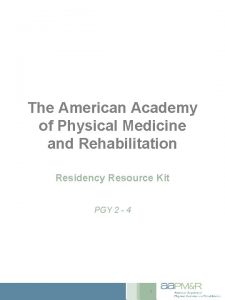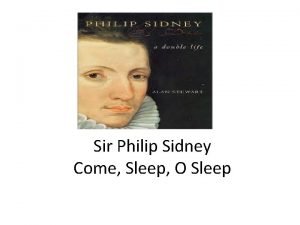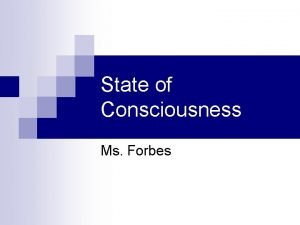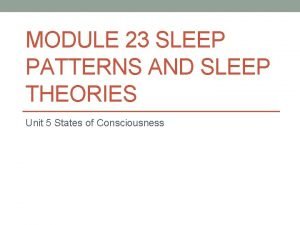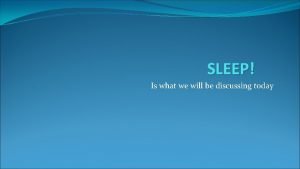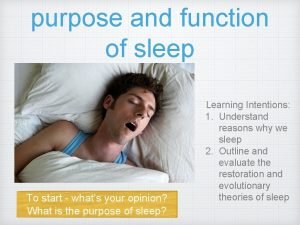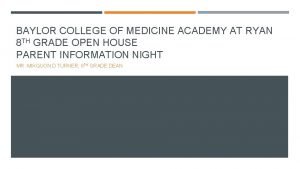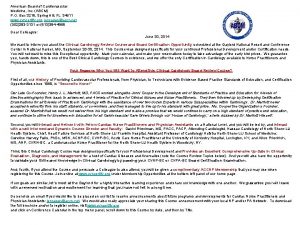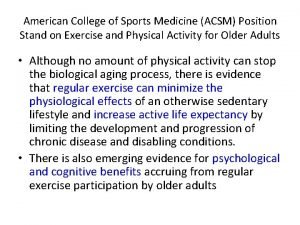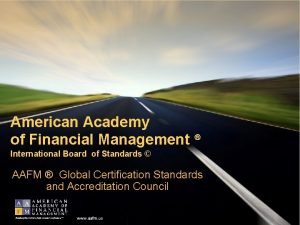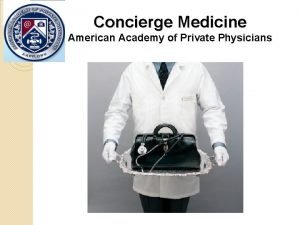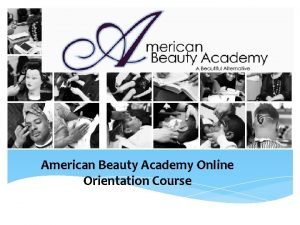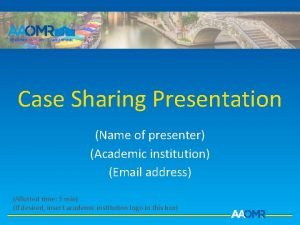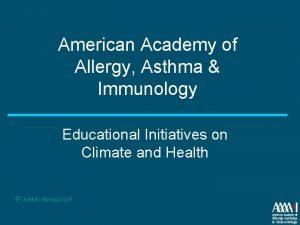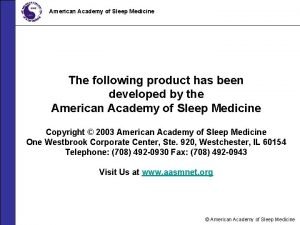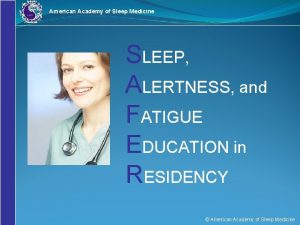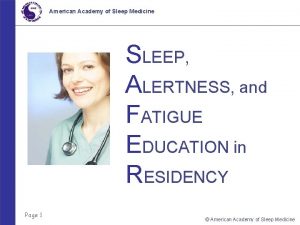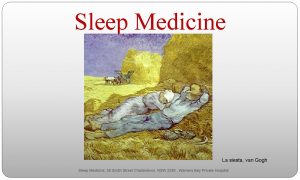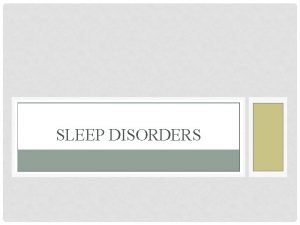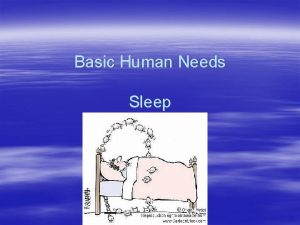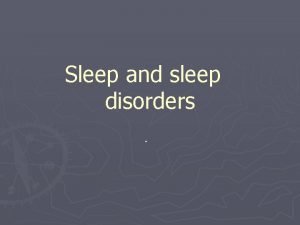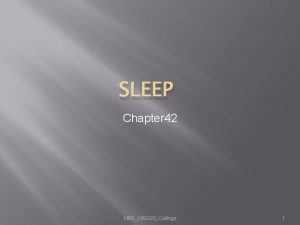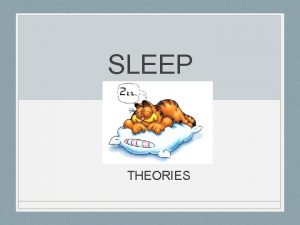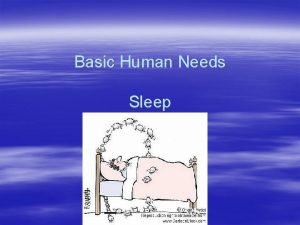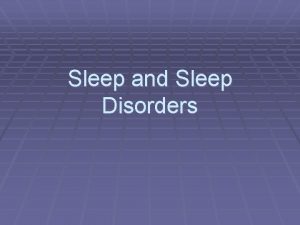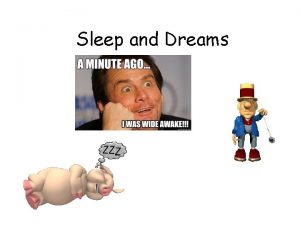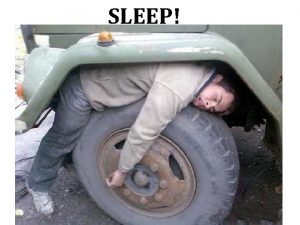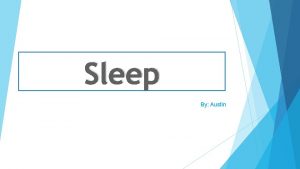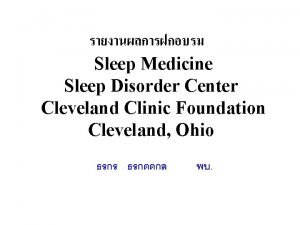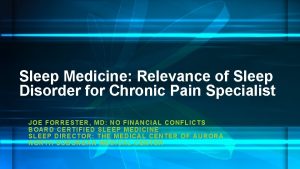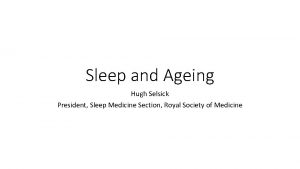American Academy of Sleep Medicine The following product


























































- Slides: 58

American Academy of Sleep Medicine The following product has been developed by the American Academy of Sleep Medicine Copyright © 2003 American Academy of Sleep Medicine One Westbrook Corporate Center, Ste. 920, Westchester, IL 60154 Telephone: (708) 492 -0930 Fax: (708) 492 -0943 Visit Us at www. aasmnet. org © American Academy of Sleep Medicine

American Academy of Sleep Medicine SLEEP, ALERTNESS, and FATIGUE EDUCATION in RESIDENCY © American Academy of Sleep Medicine

American Academy of Sleep Medicine Learning Objectives 1. List factors that put you at risk for sleepiness and fatigue. 2. Describe the impact of sleep loss on residents’ personal and professional lives. 3. Recognize signs of sleepiness and fatigue in yourself and others. 4. Challenge common misconceptions among physicians about sleep and sleep loss. 5. Adapt alertness management tools and strategies for yourself and your program. © American Academy of Sleep Medicine

American Academy of Sleep Medicine The Scope of the Problem “… I always had a prior theory that when you look up all the old sixties research how do you brainwash someone? You sleep deprive them. That’s number, two, and three. Sleep deprive them. You feed them bad food and you repeat things over and over again. It’s like that kind of covers residency. ” © American Academy of Sleep Medicine

American Academy of Sleep Medicine Despite this, the problem of sleepiness and fatigue in residency is underestimated. © American Academy of Sleep Medicine

American Academy of Sleep Medicine Epworth Sleepiness Scale Sleepiness in residents is equivalent to that found in patients with serious sleep disorders. Mustafa and Strohl, unpublished data. Papp, 2002 © American Academy of Sleep Medicine

American Academy of Sleep Medicine Why So? • Physicians know relatively little about sleep needs and sleep physiology. • There is no “drug test” for sleepiness. • Most programs do not recognize and address the problem of resident sleepiness. • The culture of medicine says: • “Sleep is “optional” (and you’re a wimp if you need it)” • “Less sleep = more dedicated doc” © American Academy of Sleep Medicine

American Academy of Sleep Medicine What causes sleepiness? © American Academy of Sleep Medicine

American Academy of Sleep Medicine Myth: “It’s the really boring noon conferences that put me to sleep. ” Fact: Environmental factors (passive learning situation, room temperature, low light level, etc) may unmask but DO NOT CAUSE SLEEPINESS. © American Academy of Sleep Medicine

American Academy of Sleep Medicine Conceptual Framework (in Residency) Insufficient Sleep (on call sleep loss/inadequate recovery sleep) Fragmented Sleep (pager, phone calls) EXCESSIVE DAYTIME SLEEPINESS Circadian Rhythm Disruption (night float, rotating shifts) Primary Sleep Disorders (sleep apnea, etc) © American Academy of Sleep Medicine

American Academy of Sleep Medicine Sleep Needed vs Sleep Obtained • Myth: “I’m one of those people who only need 5 hours of sleep, so none of this applies to me. ” • Fact: Individuals may vary somewhat in their tolerance to the effects of sleep loss, but are not able to accurately judge this themselves. • Fact: Human beings need 8 hours of sleep to perform at an optimal level. • Fact: Getting less than 8 hours of sleep starts to create a “sleep debt” which must be paid off. © American Academy of Sleep Medicine

American Academy of Sleep Medicine Sleep Fragmentation Affects Sleep Quality NORMAL SLEEP = Paged MORNING ROUNDS ON CALL SLEEP © American Academy of Sleep Medicine

American Academy of Sleep Medicine The Circadian Clock Impacts You • It is easier to stay up later than to try to fall asleep earlier. • It is easier to adapt to shifts in forward (clockwise) direction (day evening night). • Night owls may find it easier to adapt to night shifts. © American Academy of Sleep Medicine

American Academy of Sleep Medicine Interaction of Circadian Rhythms and Sleep Homeostatic drive (Sleep Load) Wake Sleep Alertness level Circadian alerting signal 9 AM 3 PM 9 PM Time 3 AM 9 AM © American Academy of Sleep Medicine

American Academy of Sleep Medicine Sleep Disorders: Are you at risk? • Physicians can have sleep disorders too! -- Obstructive sleep apnea -- Restless legs syndrome -- Periodic limb movement disorder -- Learned or “conditioned” insomnia -- Medication-induced insomnia © American Academy of Sleep Medicine

American Academy of Sleep Medicine Adaptation to Sleep Loss Myth: “I’ve learned not to need as much sleep during my residency. ” Fact: Sleep needs are genetically determined and cannot be changed. Fact: Human beings do not “adapt” to getting less sleep than they need. Fact: Although performance of tasks may improve somewhat with effort, optimal performance and consistency of performance do not! © American Academy of Sleep Medicine

American Academy of Sleep Medicine Consequences of Chronic Sleep Deprivation Sleep is a vital and necessary function, and sleep needs (like hunger and thirst) must be met. © American Academy of Sleep Medicine

American Academy of Sleep Medicine © American Academy of Sleep Medicine

American Academy of Sleep Medicine • Surgery: 20% more errors and 14% more time required to perform simulated laparoscopy post-call (two studies) Taffinder et al, 1998; Grantcharov et al, 2001 • Internal Medicine: efficiency and accuracy of ECG interpretation impaired in sleep -deprived interns Lingenfelser et al, 1994 • Pediatrics: time required to place an intra-arterial line increased significantly in sleepdeprived Storer et al, 1989 © American Academy of Sleep Medicine

American Academy of Sleep Medicine Across Tasks Emergency Medicine: significant reductions in comprehensiveness of history & physical exam documentation in second-year residents Bertram 1988 Family Medicine: scores achieved on the ABFM practice in-training exam negatively correlated with pre-test sleep amounts Jacques et al 1990 © American Academy of Sleep Medicine

American Academy of Sleep Medicine Impact on Professionalism “Your own patients have become the enemy…because they are the one thing that stands between you and a few hours of sleep. ” © American Academy of Sleep Medicine

American Academy of Sleep Medicine Work Hours, Medical Errors, and Workplace Conflicts by Average Daily Hours of Sleep* *Baldwin and Daugherty, 1998 -9 Survey of 3604 PGY 1, 2 Residents © American Academy of Sleep Medicine

American Academy of Sleep Medicine Bottom Line: You need to be alert to take the best possible care of your patients and yourself. © American Academy of Sleep Medicine

American Academy of Sleep Medicine Adverse Health Consequences by Average Daily Hours of Sleep* *Baldwin and Daugherty, 1998 -9 Survey of 3604 PGY 1, 2 Residents © American Academy of Sleep Medicine

American Academy of Sleep Medicine Sleep Loss and Fatigue: Safety Issues • 58% of emergency medicine residents reported near-crashes driving. -- 80% post night-shift -- Increased with number of night shifts/month Steele et al 1999 • 50% greater risk of blood-borne pathogen exposure incidents (needlestick, laceration, etc) in residents between 10 pm and 6 am. Parks 2000 © American Academy of Sleep Medicine

American Academy of Sleep Medicine Impact on Medical Education “We all know that you stop learning after 12 or 13 or 14 hours. You don’t learn anything except how to cut corners and how to survive. ” © American Academy of Sleep Medicine

American Academy of Sleep Medicine Impact on Medical Education • Residents working longer hours report decreased satisfaction with learning environment and decreased motivation to learn. Baldwin et al 1997 • Study of surgical residents showed less operative participation associated with more frequent call. Sawyer et al 1999 © American Academy of Sleep Medicine

American Academy of Sleep Medicine Impact on Medical Errors • Surveys: more than 60 % of anesthesiologists report making fatigue-related errors. Gravenstein 1990 • Case Reviews: - 3% of anesthesia incidents Morris 2000 - 5% “preventable incidents” “fatigue-related” - 10% drug errors Williamson 1993 - Post-op surgical complication rates 45%, higher if resident was post-call Haynes et al 1995 © American Academy of Sleep Medicine

American Academy of Sleep Medicine Recognizing Sleepiness in Yourself and Others © American Academy of Sleep Medicine

American Academy of Sleep Medicine • Myth: “If I can just get through the night (on call), I’m fine in the morning. ” • Fact: A decline in performance starts after about 15 -16 hours of continued wakefulness. • Fact: The period of lowest alertness after being up all night is between 6 am and 11 am (eg, morning rounds). © American Academy of Sleep Medicine

American Academy of Sleep Medicine Estimating Sleepiness Myth: “I can tell how tired I am and I know when I’m not functioning up to par. ” Fact: Studies show that sleepy people underestimate their level of sleepiness and overestimate their alertness. Fact: The sleepier you are, the less accurate your perception of degree of impairment. Fact: You can fall asleep briefly (“microsleeps”) without knowing it! © American Academy of Sleep Medicine

American Academy of Sleep Medicine Anesthesia Resident Study • Residents did not perceive themselves to be asleep almost half of the time they had actually fallen asleep. • Residents were wrong 76% of the time when they reported having stayed awake. Howard et al 2002 © American Academy of Sleep Medicine

American Academy of Sleep Medicine Recognize The Warning Signs of Sleepiness • Falling asleep in conferences or on rounds • Feeling restless and irritable with staff, colleagues, family, and friends • Having to check your work repeatedly • Having difficulty focusing on the care of your patients • Feeling like you really just don’t care © American Academy of Sleep Medicine

American Academy of Sleep Medicine If you don’t recognize that you’re sleepy, you’re not likely to do anything about it. © American Academy of Sleep Medicine

American Academy of Sleep Medicine Alertness Management Strategies © American Academy of Sleep Medicine

American Academy of Sleep Medicine Myth: “I’d rather just “power through” when I’m tired; besides, even when I can nap, it just makes me feel worse. ” Fact: Some sleep is always better than no sleep. Fact: At what time and for how long you sleep are key to getting the most out of napping. © American Academy of Sleep Medicine

American Academy of Sleep Medicine Napping Pros: Naps temporarily improve alertness. Types: preventative (pre-call) operational (on the job) Length: short naps: no longer than 30 minutes to avoid the grogginess (“sleep inertia”) that occurs when you’re awakened from deep sleep long naps: 2 hours (range 30 to 180 minutes) © American Academy of Sleep Medicine

American Academy of Sleep Medicine Napping Timing: -- if possible, take advantage of circadian “windows of opportunity” (2 -5 am and 2 -5 pm); -- but if not, nap whenever you can! Cons: sleep inertia; allow adequate recovery time (15 -30 minutes) Bottom line: Naps take the edge off but do not replace adequate sleep. © American Academy of Sleep Medicine

American Academy of Sleep Medicine Healthy Sleep Habits Get adequate (7 to 9 hours) sleep before anticipated sleep loss. Avoid starting out with a sleep deficit! © American Academy of Sleep Medicine

American Academy of Sleep Medicine Recovery from Sleep Loss Myth: “All I need is my usual 5 to 6 hours the night after call and I’m fine. ” Fact: Recovery from on-call sleep loss generally takes 2 nights of extended sleep to restore baseline alertness. Fact: Recovery sleep generally has a higher percentage of deep sleep, which is needed to counteract the effects of sleep loss. © American Academy of Sleep Medicine

on MSLT (min) Time to fall asleep American Academy of Sleep Medicine Howard 2002 Sleepiness level post-call vs on a normal (baseline) schedule was equivalent in anesthesia residents. A period of extended sleep (over 4 nights) normalized post -call sleepiness levels. © American Academy of Sleep Medicine

American Academy of Sleep Medicine Healthy Sleep Habits • Go to bed and get up at about the same time every day. • Develop a pre-sleep routine. • Use relaxation to help you fall asleep. • Protect your sleep time; enlist your family and friends! © American Academy of Sleep Medicine

American Academy of Sleep Medicine Healthy Sleep Habits • Sleeping environment: – Cooler temperature – Dark (eye shades, room darkening shades) – Quiet (unplug phone, turn off pager, use ear plugs, white noise machine) • Avoid going to bed hungry, but no heavy meals within 3 hours of sleep. • Get regular exercise but avoid heavy exercise within 3 hours of sleep. © American Academy of Sleep Medicine

American Academy of Sleep Medicine Recognize Signs of DWD * • Trouble focusing on the road • Difficulty keeping your eyes open • Nodding • Yawning repeatedly • Drifting from your lane, missing signs or exits • Not remembering driving the last few miles • Closing your eyes at stoplights * Driving While Drowsy © American Academy of Sleep Medicine

American Academy of Sleep Medicine Risk Factors for Drowsy Driving Taking any sedating medications Drinking even small amounts of alcohol Having a sleep disorder (sleep apnea) Driving long distances without breaks Driving alone or on a boring road Number of Crashes • • • Pack et al 1995 Time of Day Driving home post-call © American Academy of Sleep Medicine

American Academy of Sleep Medicine Drive Smart; Drive Safe • AVOID driving if drowsy. • If you are really sleepy, get a ride home, take a taxi, or use public transportation. • Take a 20 minute nap and/or drink a cup of coffee before going home post-call. • Stop driving if you notice the warning signs of sleepiness. • Pull off the road at a safe place, take a short nap. © American Academy of Sleep Medicine

American Academy of Sleep Medicine Drowsy Driving: What Does Not Work • • • Turning up the radio Opening the car window Chewing gum Blowing cold air (water) on your face Slapping (pinching) yourself hard Promising yourself a reward for staying awake © American Academy of Sleep Medicine

American Academy of Sleep Medicine It takes only a 4 second lapse in attention to have a drowsy driving crash. © American Academy of Sleep Medicine

American Academy of Sleep Medicine Drugs • Melatonin: little data in residents • Hypnotics: may be helpful in specific situations (eg, persistent insomnia) • AVOID: using stimulants (methylphenidate, dextroamphetamine, modafinil) to stay awake • AVOID: using alcohol to help you fall asleep; it induces sleep onset but disrupts sleep later on © American Academy of Sleep Medicine

American Academy of Sleep Medicine Caffeine • Strategic consumption is key • Effects within 15 – 30 minutes; half-life 3 to 7 hours • Use for temporary relief of sleepiness • Cons: – disrupts subsequent sleep (more arousals) – tolerance may develop – diuretic effects © American Academy of Sleep Medicine

American Academy of Sleep Medicine Adapting To Night Shifts • Myth: “I get used to night shifts right away; no problem. ” • Fact: It takes at least a week for circadian rhythms and sleep patterns to adjust. • Fact: Adjustment often includes physical and mental symptoms (think jet lag). • Fact: Direction of shift rotation affects adaptation (forward/clockwise easier to adapt). © American Academy of Sleep Medicine

American Academy of Sleep Medicine How To Survive Night Float • Protect your sleep. • Nap before work. • Consider “splitting” sleep into two 4 hour periods. • Have as much exposure to bright light as possible when you need to be alert. • Avoid light exposure in the morning after night shift (be cool and wear dark glasses driving home from work). © American Academy of Sleep Medicine

American Academy of Sleep Medicine “The best laid plans…” Study: Impact of night float coverage (2 am to 6 am) Results: “protected” interns slept less than controls; used time to catch up on work, not sleep; thus there was no improvement in performance Richardson et al 1996 © American Academy of Sleep Medicine

American Academy of Sleep Medicine Alertness Strategies • There is no “magic bullet. ” • Know your own vulnerability to sleep loss. • Learn what works for you from a range of strategies. • There needs to be a shared responsibility for fatigue management and a “culture of support” in the training program. © American Academy of Sleep Medicine

American Academy of Sleep Medicine In Summary… • Fatigue is an impairment like alcohol or drugs. • Drowsiness, sleepiness, and fatigue cannot be eliminated in residency, but can be managed. • Recognition of sleepiness and fatigue and use of alertness management strategies are simple ways to help combat sleepiness in residency. • When sleepiness interferes with your performance or health, talk to your supervisors and program director. © American Academy of Sleep Medicine

American Academy of Sleep Medicine For More Information Contact: Your local Sleep Education Advocate or visit www. aasmnet. org/MEDSleepprogram. htm © American Academy of Sleep Medicine

American Academy of Sleep Medicine “Patients have a right to expect a healthy, alert, responsible, and responsive physician. ” January 1994 statement by American College of Surgeons Re-approved and re-issued June 2002 © American Academy of Sleep Medicine

American Academy of Sleep Medicine Certificate of Completion Type Your Name Here Has completed the SAFER Training of the American Academy of Sleep Medicine © American Academy of Sleep Medicine
 Aapmr job board
Aapmr job board Come sleep
Come sleep Adults spend about ______% of their sleep in rem sleep.
Adults spend about ______% of their sleep in rem sleep. Module 16 sleep patterns and sleep theories
Module 16 sleep patterns and sleep theories Module 23 sleep patterns and sleep theories
Module 23 sleep patterns and sleep theories Module 23 sleep patterns and sleep theories
Module 23 sleep patterns and sleep theories Baylor college of medicine academy at ryan middle school
Baylor college of medicine academy at ryan middle school Native american color wheel
Native american color wheel American board of cardiovascular medicine
American board of cardiovascular medicine What does acsm stand for
What does acsm stand for American academy of financial management
American academy of financial management The concierge academy
The concierge academy African american beauty academy
African american beauty academy American academy of oral and maxillofacial radiology
American academy of oral and maxillofacial radiology American academy of witchcraft arts
American academy of witchcraft arts American academy of allergy asthma and immunology 2018
American academy of allergy asthma and immunology 2018 Hình ảnh bộ gõ cơ thể búng tay
Hình ảnh bộ gõ cơ thể búng tay Frameset trong html5
Frameset trong html5 Bổ thể
Bổ thể Tỉ lệ cơ thể trẻ em
Tỉ lệ cơ thể trẻ em Voi kéo gỗ như thế nào
Voi kéo gỗ như thế nào Tư thế worm breton là gì
Tư thế worm breton là gì Alleluia hat len nguoi oi
Alleluia hat len nguoi oi Các môn thể thao bắt đầu bằng từ đua
Các môn thể thao bắt đầu bằng từ đua Thế nào là hệ số cao nhất
Thế nào là hệ số cao nhất Các châu lục và đại dương trên thế giới
Các châu lục và đại dương trên thế giới Công thức tính thế năng
Công thức tính thế năng Trời xanh đây là của chúng ta thể thơ
Trời xanh đây là của chúng ta thể thơ Cách giải mật thư tọa độ
Cách giải mật thư tọa độ Phép trừ bù
Phép trừ bù Phản ứng thế ankan
Phản ứng thế ankan Các châu lục và đại dương trên thế giới
Các châu lục và đại dương trên thế giới Thơ thất ngôn tứ tuyệt đường luật
Thơ thất ngôn tứ tuyệt đường luật Quá trình desamine hóa có thể tạo ra
Quá trình desamine hóa có thể tạo ra Một số thể thơ truyền thống
Một số thể thơ truyền thống Bàn tay mà dây bẩn
Bàn tay mà dây bẩn Vẽ hình chiếu vuông góc của vật thể sau
Vẽ hình chiếu vuông góc của vật thể sau Biện pháp chống mỏi cơ
Biện pháp chống mỏi cơ đặc điểm cơ thể của người tối cổ
đặc điểm cơ thể của người tối cổ V cc cc
V cc cc Vẽ hình chiếu đứng bằng cạnh của vật thể
Vẽ hình chiếu đứng bằng cạnh của vật thể Fecboak
Fecboak Thẻ vin
Thẻ vin đại từ thay thế
đại từ thay thế điện thế nghỉ
điện thế nghỉ Tư thế ngồi viết
Tư thế ngồi viết Diễn thế sinh thái là
Diễn thế sinh thái là Dạng đột biến một nhiễm là
Dạng đột biến một nhiễm là Các số nguyên tố là gì
Các số nguyên tố là gì Tư thế ngồi viết
Tư thế ngồi viết Lời thề hippocrates
Lời thề hippocrates Thiếu nhi thế giới liên hoan
Thiếu nhi thế giới liên hoan ưu thế lai là gì
ưu thế lai là gì Khi nào hổ con có thể sống độc lập
Khi nào hổ con có thể sống độc lập Sự nuôi và dạy con của hổ
Sự nuôi và dạy con của hổ Sơ đồ cơ thể người
Sơ đồ cơ thể người Từ ngữ thể hiện lòng nhân hậu
Từ ngữ thể hiện lòng nhân hậu Thế nào là mạng điện lắp đặt kiểu nổi
Thế nào là mạng điện lắp đặt kiểu nổi New product development and product life cycle strategies
New product development and product life cycle strategies
